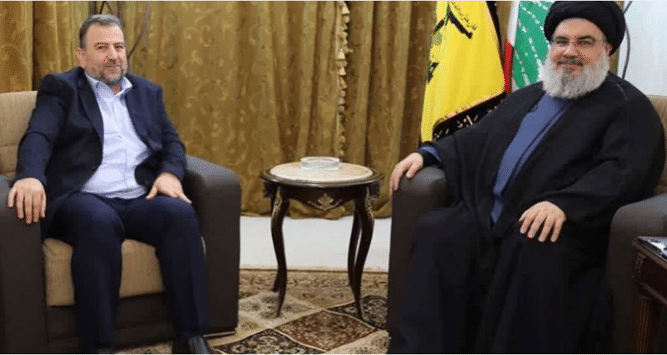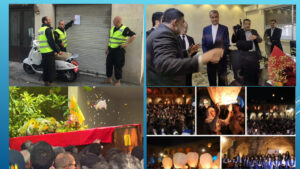The history of relations between Iran, Hezbollah, and Hamas (or: radical Shiite axis relations with the Sunni Muslim Brotherhood)
The relationship between Iran and Hamas began in the early 1990s, three years after Hamas was founded. Over the years, Hamas enjoyed Iranian financial support for its smuggled weapons, which intensified when Hamas came to power in the Gaza Strip in June 2007. After Hamas took over the Gaza Strip, Iran and even Hezbollah began aiding Hamas to develop its own weapons. Khaled Mashal, former leader of Hamas’ political bureau, stated in 2007 that “Hamas is the spiritual son of Khomeini (the founder of the Islamic Revolution in Iran).

Despite the “honeymoon” described above, Hamas supported the rebel camp when the Syrian civil war broke out. Hamas chose to support the side that acted against the radical Shiite axis headed by Iran. In response, the Assad regime closed all Hamas offices in Syria in 2012. Consequently, Hamas transferred its headquarters from Syria to Qatar and Turkey. Khalid Mashal even proudly hoisted the Free Syrian Army Flag at the entrance of his office.
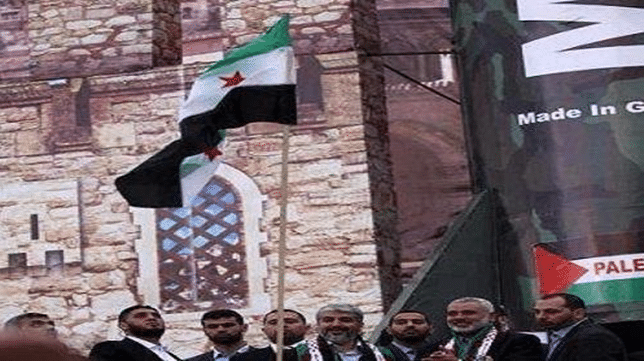
Hamas chose to side with its parent movement, the Muslim Brotherhood, which at the time ruled Egypt after the overthrow of President Mubarak. In light of this, Hamas felt confident to abandon the radical Shiite axis headed by Iran. Hamas’s assumption was that an Arab power in the form of Egypt would stand behind it. Hamas did not know the Muslim Brotherhood would be overthrown in Egypt shortly thereafter.
Hamas was also physically involved in the Syrian civil war. A Palestinian faction called Aknaf Beit al-Maqdis, headed by one of the commanders of Hamas’s military-terrorist wing, Nadal Abu al-Alaa actively took part in the fighting against the Syrian regime in the Al-Yarmouk refugee camp in Damascus. The faction specialized in gathering intelligence, planting IEDs, detonating car bombs, and even digging tunnels in the al-Ghuta al-Sharqiya area of Damascus, using the experience gained in Gaza.
Friction between Hezbollah and Hamas became apparent both in the civilian/political and military aspects. In May 2013, the Jerusalem Post reported that Hezbollah had demanded that Hamas halt its political activities in Lebanon. Hamas’s members vigorously denied these remarks. Another sign of tension at the time was the burning of Hezbollah aid sent to the ain al-Hilweh Palestinian refugee camp in Sidon. Tensions were high at the time, when rockets launched by rebel supporters in Syria on May 26, 2013, fell in the Dahieh (the Hezbollah stronghold neighborhood). A Hamas operative named Alaa al-Din Mahmoud from the al-Rashadiyeh refugee camp in Tyre was involved in the shooting.
We are familiar with Hezbollah’s dissatisfaction with Hamas’s military activity against Israel since the summer of 2014. During operation “Protective Edge” in the Gaza Strip, Grad rockets were fired from southern Lebanon into Israel by Hamas proxies. Hezbollah requested Lebanese army intelligence, which was being assisted by members of Fatah (Hamas’ main rival in the Palestinian arena) to gather intelligence regarding senior Hamas figures in the al-Rashadiyeh refugee camp near Tyre. In this context, senior Hamas members’ apartments and mosques were monitored in both al-Rashadiyeh and other Palestinian refugee camps in Lebanon
In 2012, Osama Hamdan, Hamas’ foreign portfolio holder, stated that relations between Hamas, Iran, and Hezbollah had been frozen because of disagreements regarding Syria. In practice, Hamas’ relations with Iran were not completely frozen, at least not in the military context. Hamas’ delegations were sent to Iran, mainly in light of Iranian military interests in maintaining the relationship from a strategic view against Israel. A prominent opponent of the severing of relations was Mahmoud al-Zahar, a senior Hamas figure who demanded that, besides the integrity of the military ties, Hamas should also tighten its political relations with Iran.
Iran and Hezbollah seemed to have agreed, after a few years in which there was no significant progress or decisiveness in the Syrian arena, to put their differences with Hamas on the Syrian issue aside (or in other words, put the interests before ideology). In May 2017, under Iranian auspices, Hezbollah held a series of meetings with senior Hamas figures. At the end of the meetings, they agreed to increase Iran’s support for Hamas. This was despite Hamas’s unchanged opinion regarding the Syrian crisis. Even then, Hezbollah tried to lead a reconciliation between Hamas and Syria, but a complete refusal from Damascus prevented this. Syria would not forget what Hamas had done at the beginning of the civil war in the al-Yarmouk refugee camp.
Saleh al-Arouri, who serves as deputy head of Hamas’s political bureau and activities in the Palestinian Authority in Judea and Samaria (Ismail Haniya is the head of the political bureau today. The head of the political bureau is considered the Hamas leader), clarified: In an interview with the Iranian Shrek newspaper, al-Arouri noted that “Hamas’s ‘relations with Iran and Hezbollah have nothing to do with Hamas’ relations with Syria. He denied that Hamas took sides in the Syrian crisis and said that Hamas did not and never will.” Asked how much trust Iran has in Hamas after Hamas took a neutral stance on the conflict, al-Arouri replied: “No one has demanded that we take sides in any regional conflict and will not do so in the future.”
Al-Arouri headed a delegation composed of senior Hamas figures from Lebanon, the Gaza Strip, and Turkey which met with Supreme Leader Khamenei, and during the meeting, Khamenei noted that “the issue of Palestine is the most important and first issue on the Islamic world’s agenda… Palestine is a religious and ideological issue.”
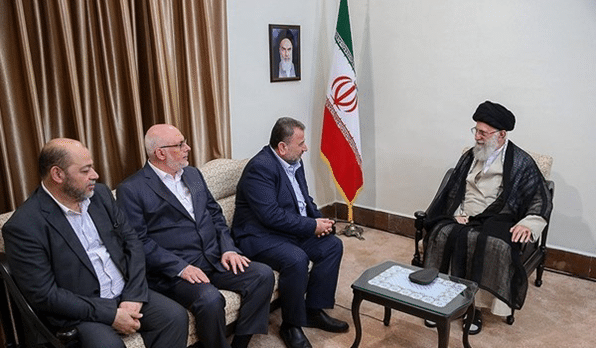
Khamenei seems to have found the unity between the ideology of the radical Shiite axis and the ideology of the Sunni Muslim Brotherhood, with Hamas as its representative. Instead of focusing on the Shiite religious ideology that connects Iran, Hezbollah, the Shiite militias, and the Houthis, Iran has turned “Palestine” into an ideology itself. In this way, Iran can connect many elements in the Middle East, including Sunni elements such as Hamas and the Palestinian Islamic Jihad (PIJ) against Israel. Syria is not sacred. Syria is another part of the same axis that makes opposition to Israel’s existence accessible on another front, another country with a border with Israel. In May 2021, during the escalation in the Gaza Strip, the above “connection” was clearly expressed. All elements of the radical Shiite axis and all Palestinian organizations united their public statements under the issue of the protection of “Palestine” and “Al-Quds” (Jerusalem).
With the outbreak of the civil protests in Lebanon in October 2019, additional tensions arose between Hezbollah and Hamas and among Hamas members in Lebanon. Hamas’s silence and failure to take a stand in favor of Hezbollah supporters provoked Nasrallah’s anger as he expected Hamas to stand with Hezbollah at least publicly. Hezbollah noted that Hamas had not learned at all from the case with Syria and had frozen any contact and mediation attempts between Syria and Hamas (before that, in July 2019, there were apparent informal meetings between senior Hamas figures and senior Syrian officials mediated by Hezbollah. Assad set an explicit condition for Hamas to normalize relations – a public apology by the Hamas leadership in a press conference).
It is claimed that Hezbollah leadership received proof that Hamas was not fit to be part of the “axis of resistance” and that Nasrallah personally asked Qassem Soleimani to take action against Hamas. PIJ tried to reconcile the rifts between Hezbollah and Hamas, but Hezbollah requested that it not intervene at all.
In June 2020, an Iranian spy, recruited with Hezbollah’s help, was exposed apparently following Musa Abu Marzuq, one of Hamas’s senior figures in the Gaza Strip (formerly Hamas’ foreign relations chief) on his various trips. Hamas was deeply offended by Hezbollah and Iran, and Ismail Haniyeh spoke with Nasrallah about the issue. The spy was deported to Sudan. At the time, Abu Marzuq was considered an opponent of tightening ties with Iran. He was quoted in the Kuwaiti Al-Jaridah as saying that “in order to deal with the “deal of the century,” Hamas should approach the Arab countries and not the internationally isolated Iran.”
In early 2021, Iran and Hezbollah continued their effort to reconcile Hamas and the Syrian regime. In June 2021, Ismail Haniya visited Lebanon and during the visit, he met Nasrallah. The two emphasized the depth of the ties between Hezbollah and Hamas and their importance in the struggle against Israel. It is possible that, among other things, the two also discussed attempts at reconciliation with the Syrian regime. However, in July 2021, Khaled Mashal, the former chairman of Hamas’ political bureau, dampened the hope for reconciliation. In an interview with al-Arabiya, he said that Iran was not currently mediating between Hamas and the Syrian regime and that there was nothing new on the subject. He also made it clear that he opposed Hezbollah’s intervention in Syria.
Recently (2021), an article was published in the Egyptian daily “al-Yume” which spoke of concern among the residents of the Gaza Strip regarding the Shiiteization of the Gaza Strip due to the tightening of the relationship between the radical Shiite axis led by Iran and Hamas, especially after the events of the escalation in May 2021 (“Guardian of the Walls”).
It is our understanding that the issue above was based on several interesting phenomena, which included hanging many posters with Soleimani’s portrait after his elimination in January 2020. The most prominent sign of Shiiteization in the Gaza Strip is the establishment of the “al-Saberin Nasra for Palestine-Hatzen” organization in the Gaza Strip in May 2014 by Hisham Salem. “al-Saberin” is an independent organization with armed operatives who espouses Shiite ideology by the distribution of charity to the poor in the Gaza Strip. “Al-Saberin” was established and is funded under Iranian auspices on a budget of about $12 million a year.
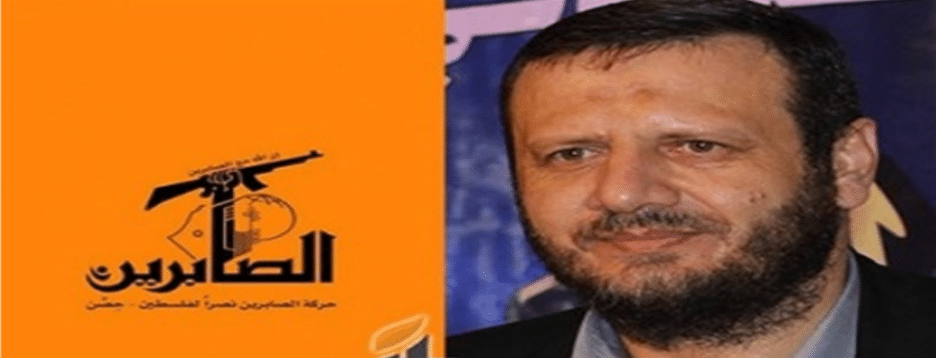
Hamas, which saw “al-Saberin” as an attempt by the radical Shiite axis led by Iran to establish a lever of influence on its territory, did not like the establishment of the group and began harassing its activities. As a result, Iran set the ceasing of the harassment as a condition to the continued assistance to Hamas. In February 2019, Salem was arrested by Hamas and released a few months later with Iranian intervention. Hamas took advantage of his detention and worked to dismantle “al-Saberin,” which was considered Iran’s direct military wing in the Gaza Strip.
The common interest against Israel trumps the differences in the unlike religious ideology. The common interest allows the radical Shiite axis led by Iran to cooperate with the Sunni Muslim Brotherhood represented by Hamas. Instead of a different religious doctrine, they created a common ideology – “The Ideology of Palestine.”
It seems that among Hamas’s policymakers, there are disagreements regarding the nature of relations with the Shiite axis. This may have influenced Hamas’ volatile behavior toward the Syrian regime and towards the radical Shiite axis headed by Iran. However, at present, Hamas leader Ismail Haniyeh supports strengthening relations with the axis.
It is estimated that Hamas’s military force building in the Gaza Strip and Lebanon was not affected by the change in relations. However, the volatility in Hamas’s attitude towards the Shiite axis and Hezbollah should serve as a warning sign mainly for Hezbollah. Iran is able to instruct Hamas to act militarily and independently from Lebanon, compartmentalizing Hezbollah. Moreover, Hamas can operate militarily from Lebanon even without Iran’s explicit instructions. Such independent actions pose quite a challenge for Hezbollah.
The radical Shiite axis led by Iran and Hamas has mutually dependent on each other. Hamas does not necessarily listen to Iran and is not considered a classic proxy in this sense. However, Iran sees Hamas as a leader in the Palestinian arena, and therefore, for Iran, “there is no choice” but to hug Hamas and keep it close. Hamas, on its part, also understands that “there is no choice” and that Iran is the only source of military and financial assistance.
In our assessment, despite the mutual dependence, Hamas, as the “protector of all Palestinians,” will act in Lebanon according to its interests, even if it harms Hezbollah, which considers itself to be “the protector of all Lebanese.”
*This article was first published in October 2021 as part of a comprehensive report on Hamas’ establishment in Lebanon.

